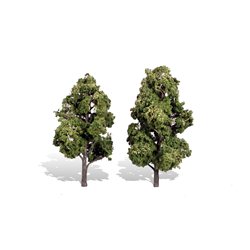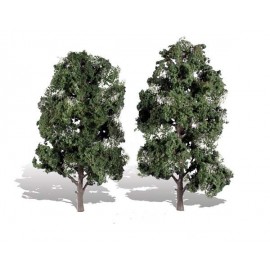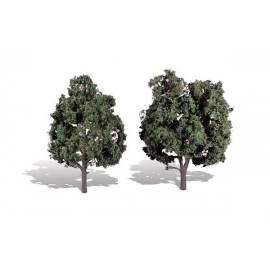Photoetched parts are small parts made of metal, manufactured using the photo etching technique. This technique...
Product successfully added to your shopping cart
There are 0 items in your cart. There is 1 item in your cart.
- Home
- N gauge
- Model kits
- Other scales
- Any scale
- Bargains
- OO gauge
- Wargames
- OO gauge
- N Gauge
- Other Scale
- Any Scale
- Wargames
- Bargains
- Letter
- Tips
- Videos
Valid to UK only - excludes oversized items
Search Tips
Tips categories
Latest Tips
-
 What are the advantages of photoetched parts on plastic kits?Read more
What are the advantages of photoetched parts on plastic kits?Read more -
 What is the difference between enamel and acrylic paint?9th March 2020Posted in: PaintingRead more
What is the difference between enamel and acrylic paint?9th March 2020Posted in: PaintingRead moreEnamel was the original paint for modellers, acrylic being quite modern by comparison. Essentially the two paints...
-
 How easy is it to model in Z gauge?16th May 2022Posted in: Model RailwayRead more
How easy is it to model in Z gauge?16th May 2022Posted in: Model RailwayRead moreModelling in Z gauge is not for the faint-hearted and certainly presents a challenge or two, but surely that's the...
-
 How can I easily clean track in a tunnel?23rd April 2023Posted in: TracksRead more
How can I easily clean track in a tunnel?23rd April 2023Posted in: TracksRead moreCleaning tracks in a tunnel on a model railway can be challenging due to the limited access and confined space....
-
 Which paints are best used to paint OO/HO metal figures?13th August 2022Posted in: PaintingRead more
Which paints are best used to paint OO/HO metal figures?13th August 2022Posted in: PaintingRead moreA wide selection of hobby paint ranges can be used very effectively on metal figures.Both enamel and acrylic paints...
What is the correct size for trees modelled in OO gauge?
When modelling trees in OO gauge (1:76 scale), the correct size depends on the type of tree you are replicating and its scale height. Getting the proportions right is essential for creating a realistic railway scene. A useful starting point is to know that OO scale reduces real-world measurements by a factor of 76. Thus, a tree in real life standing at 10 metres tall would need to be about 13 cm in your model layout.
For common trees, the range of heights in OO gauge can vary significantly. For instance, a mature oak tree in real life can be 20 to 30 metres tall, so in OO scale, this translates to between 26 and 39 cm. It’s essential to consider the variety of tree species and their natural growth sizes when choosing or crafting your models. You may find that some modellers prefer trees on the shorter side, as it can make the railway scene feel more balanced. However, realism often demands taller trees, especially for rural or wooded scenes.
Smaller trees, such as birches or rowans, might only grow to 15 to 20 metres in nature. In OO gauge, these would range from 20 to 26 cm. For suburban layouts or city parks, where younger or smaller trees are often seen, such proportions can make the scene feel more authentic. Remember that not all trees in a real landscape are fully mature and younger or less developed trees can range in size considerably, providing diversity to your layout.
You may also wish to include smaller ornamental trees or hedgerows. Shrubs or hedges in real life can be around 2 metres tall, which in OO gauge would be approximately 2.6 cm. These smaller elements can add layers of detail to the edges of tracks or within gardens and parks, further enhancing the realism of your scene.
When positioning trees in your layout, it’s essential to consider their relationship with other structures and objects. For instance, houses, signal boxes or stations in OO gauge should dwarf smaller trees and shrubs but be overshadowed by the taller ones. If you model a countryside scene with full-grown oak or beech trees, they will tower over nearby buildings, just as they would in real life.
Finally, the texture and density of your trees matter too. While size is critical, ensuring that the foliage and trunk thickness are in scale will bring your scene to life. Trees made from wire armatures or specialist modelling materials are available in various sizes and many manufacturers offer trees pre-scaled for OO gauge. However, customising or making your own trees allows for more control over both size and appearance.
In conclusion, the correct size for OO gauge trees depends on the specific species, their real-world height and the scene you are creating. By paying attention to these details, you can create a layout that not only looks realistic but also feels proportionate and well-balanced. Keep in mind that varying tree sizes and types can help add depth and authenticity to your railway model.
Click here to receive the tips weekly in your mailbox. You can unsubscribe at any time.
Related products
Related posts
-
 Is static grass better than scatter?Posted in: Scenery10th April 20193 LikedI use both, separately and together. Static grass comes in various sizes from 0.5mm to 12mm while scatter is...
Is static grass better than scatter?Posted in: Scenery10th April 20193 LikedI use both, separately and together. Static grass comes in various sizes from 0.5mm to 12mm while scatter is... -
 How do I apply static grass?17th April 20191 LikedStatic grass is best applied using a static grass applicator. There are several on the market and they can apply...
How do I apply static grass?17th April 20191 LikedStatic grass is best applied using a static grass applicator. There are several on the market and they can apply... -
 What colour are tree trunks?Posted in: Scenery1st May 20190 LikedTree trunks are actually grey in colour and not brown as you would think. The next time you are out and about just...
What colour are tree trunks?Posted in: Scenery1st May 20190 LikedTree trunks are actually grey in colour and not brown as you would think. The next time you are out and about just... -
 How to make hills?3rd May 20192 LikedYou can make hills in a variety of ways. The tried and tested way is with chicken wire and papier mache. This is a...
How to make hills?3rd May 20192 LikedYou can make hills in a variety of ways. The tried and tested way is with chicken wire and papier mache. This is a... -
 How do I glue scatter?13th May 20190 LikedSelect the area where you want the scatter, then apply a layer of PVA glue, sprinkle your grass covering the glue....
How do I glue scatter?13th May 20190 LikedSelect the area where you want the scatter, then apply a layer of PVA glue, sprinkle your grass covering the glue....




